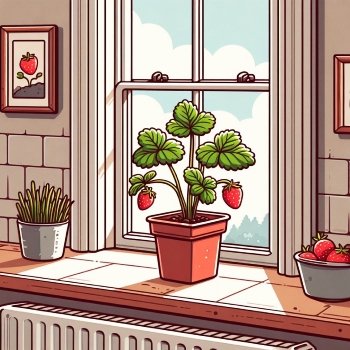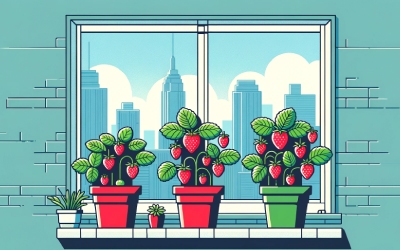Choosing the right variety of strawberry to grow indoors
Not all strawberries are created equal, especially when it comes to indoor cultivation.
Let's highlight some varieties that are particularly well-suited to your indoor garden:
Alpine strawberries
These charming, small berries are a favorite for indoor growing. They're known for their intense flavor and aroma, and they don't require as much space as some larger varieties. Plus, they can produce fruit throughout the growing season.
Day-neutral varieties
These types of strawberries, like 'Tristar' and 'Seascape', can produce fruit all year round under the right indoor conditions. They are less sensitive to the length of daylight, making them ideal for the fluctuating natural light of indoor environments.
Ever-bearing strawberries
Varieties such as 'Ozark Beauty' and 'Quinault' produce fruit in flushes throughout the growing season, giving you multiple harvests. These are great if you're looking for a steady supply of berries.
Strawberry varieties for indoor growing
| Variety |
Size |
Flavor |
Yield |
Notes |
| Alpine Strawberries |
Small |
Intensely sweet |
Moderate |
Compact growth, ideal for small spaces |
| Tristar (Day-Neutral) |
Medium |
Sweet, classic strawberry |
High |
Produces fruit throughout the year |
| Seascape (Day-Neutral) |
Large |
Bold, sweet |
High |
Less daylight sensitive, good for varying light conditions |
| Ozark Beauty (Ever-bearing) |
Medium to Large |
Juicy, sweet |
High |
Produces in flushes, needs more space |
| Quinault (Ever-bearing) |
Medium |
Sweet, slightly tart |
Moderate to High |
Good for hanging baskets, multiple harvests |
Selecting the perfect container: Size, shape, and drainage
When it comes to containers, the size, shape, and drainage are key. For strawberries, a container's depth is more crucial than its width, as their roots grow more downwards than outwards.
Choose containers at least 5-8 inches deep, ensuring they have adequate drainage holes to prevent waterlogging. Rectangular containers are great for maximizing space on windowsills, while hanging baskets can add an aesthetic touch and save space.
Artificial lighting: Ensuring adequate light
In locations lacking natural sunlight, artificial lighting becomes vital. LED grow lights or fluorescent tubes are excellent choices. Place them about 16 inches above where the plants will go, ensuring they cover the entire growing area. Remember, strawberries need about 6-8 hours of light daily to thrive, so consider using a timer for consistent light exposure.
Strawberry seed freezing technique
This bit is important, so it's worth going over in a little more detail.
The freezing seed technique is like giving your strawberry seeds a winter vacation, prepping them for a successful germination journey. Mimicking nature's cycle, this method involves a cool stint in the freezer, typically around four weeks, to break the seeds' dormancy and kickstart their readiness for growth.
Here's the play-by-play: take your strawberry seeds and tuck them snugly into an airtight container, whether it's a handy zip-lock bag or a trusty sealed jar. Pop this container into the freezer, and let the cold magic happen. During this chilly sojourn, your seeds undergo changes that make them more receptive to sprouting when they thaw out.
Here's a neat trick: toss in a small silica gel packet to keep moisture at bay, preventing any unwelcome mold surprises.

Strawberry plant maintenance
Keeping your indoor strawberry plants healthy requires regular attention. Let's dive into the key aspects:
Fertilisation
Strawberries need balanced nutrition to thrive. Use a balanced, all-purpose fertilizer once a month during the growing season. Be careful not to over-fertilize, as this can lead to lush foliage at the expense of fruit production.
Pruning runners
Runners can sap energy from fruit production. Regularly prune them, especially for container plants, to direct the plant's energy towards producing sweet, juicy berries.
Hand-pollination
Indoor plants often need a helping hand with pollination. Use a small paintbrush to gently transfer pollen from flower to flower, mimicking the work of bees. This can significantly increase your berry yield.
Rooting and spacing
Ensure proper rooting by planting in well-draining soil and not too deep. Space plants adequately to allow for air circulation and reduce the risk of fungal diseases.
Temperature management
Strawberries prefer a stable environment. Aim to maintain a room temperature between 18-24°C for optimal growth.
Harvesting and storing
Harvesting at the right time and storing your strawberries properly will maximize their shelf life and flavor.
Harvesting tips
Pick berries when they are fully red and ripe. Harvest in the morning when the berries are still cool for the best flavor. Use scissors or pinch off at the stem to avoid bruising the fruit.
Storage recommendations
Store unwashed strawberries in the refrigerator to extend their freshness. For longer storage, freeze them on a baking sheet before transferring to a freezer-safe container. This prevents the berries from sticking together.

Troubleshooting common problems
Every gardener faces challenges. Here's how to tackle some common issues with indoor strawberries.
Inadequate fruit production
Ensure adequate sunlight, proper fertilization, and consistent watering. Hand-pollinate flowers to boost fruit set.
Pest Management for Your Indoor Strawberry Haven
Spider mites: Despite being indoors, spider mites can find their way to your strawberry plants. Regularly inspect the undersides of leaves for fine webbing and mites. Combat them with a targeted spray of neem oil, a natural solution that disrupts their feeding habits without harming your cherished indoor strawberries.
Aphids: Even indoor environments aren't immune to aphids. Keep a watchful eye on the new growth and the underside of leaves for clusters of aphids. Combat them with a simple yet effective solution – insecticidal soap. This gentle soap disrupts their outer coating, effectively controlling the infestation while preserving the natural balance of your indoor strawberry patch.
Tarnished Plant Bugs: Keep a vigilant eye indoors for these bugs, as they can still find their way to your strawberry plants. If found, handpick them or use a gentle insecticidal soap to manage their presence without harming your indoor strawberries.
Disease prevention
Your indoor strawberry sanctuary deserves a shield against potential diseases. Here's how to create an environment that keeps fungal diseases at bay and ensures the well-being of your cherished indoor strawberries:
Fungal diseases: While indoors, fungal diseases can still pose a threat to your strawberries. Prioritise good air circulation by strategically placing your indoor plants. Avoid overhead watering to minimise moisture on the foliage, as excess dampness can create a welcoming environment for fungal issues. If any signs of fungal diseases appear, promptly remove affected leaves or plants to prevent the spread of the disease within your indoor strawberry haven.
Gray mould (Botrytis cinerea): Indoor spaces with limited ventilation can sometimes lead to conditions conducive to gray mold. Ensure good air circulation, and if symptoms appear, remove affected berries promptly. Consider applying a copper fungicide to prevent further spread while maintaining the pristine health of your indoor strawberries.
Powdery mildew: This common fungal disease can also affect indoor strawberries. Maintain good air circulation and monitor for the characteristic white powdery spots on leaves. Remove any affected foliage promptly, and consider applying a neem oil solution to manage the issue without compromising the health of your indoor strawberry plants.
Anthracnose: Another potential threat indoors, anthracnose can be deterred by avoiding overhead watering and maintaining optimal air circulation. If symptoms appear, remove affected parts promptly to prevent the disease's progression within your indoor strawberry oasis.
And that's that! You're now ready to grow your own indoor strawberries. Enjoy!




